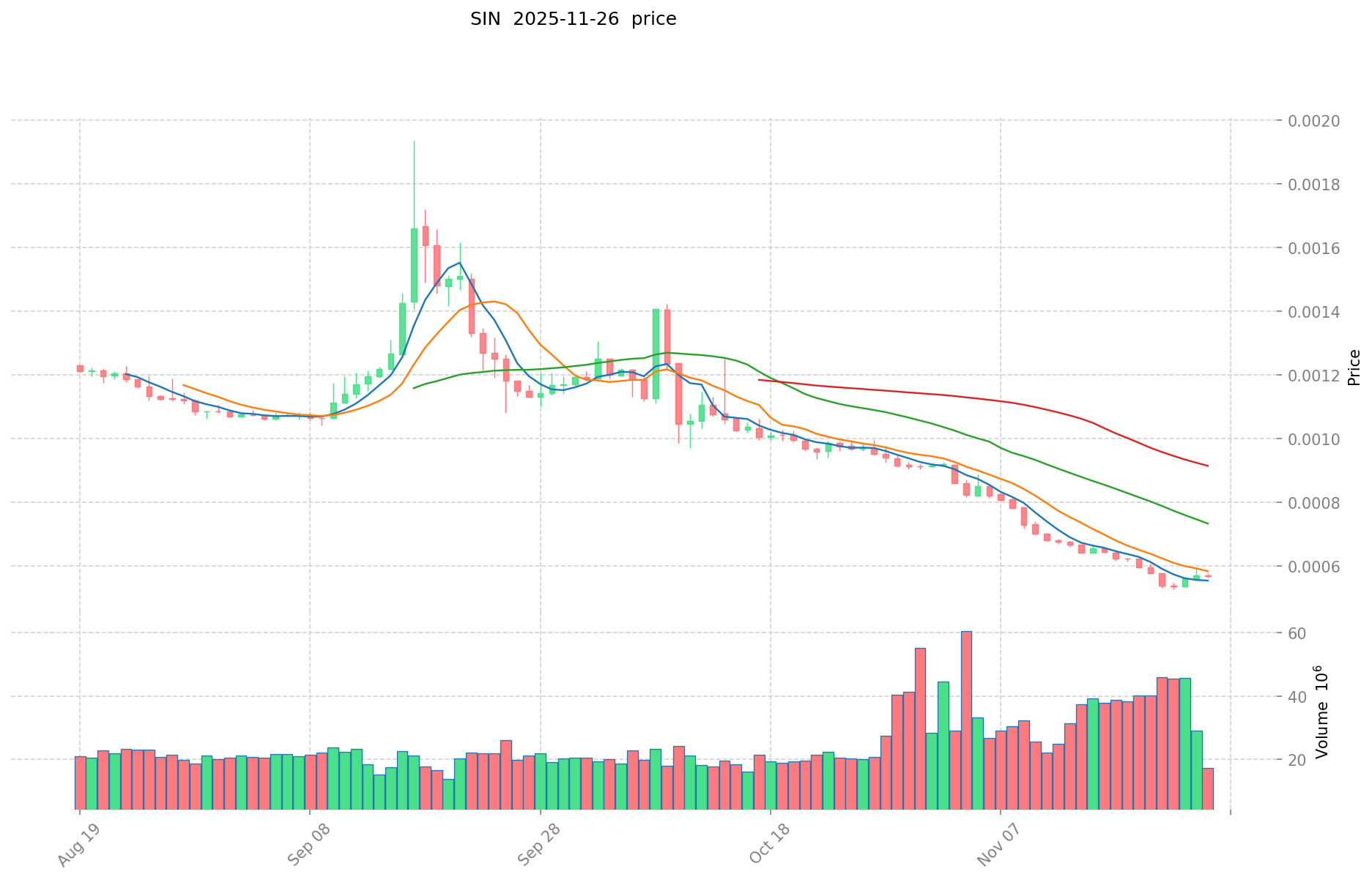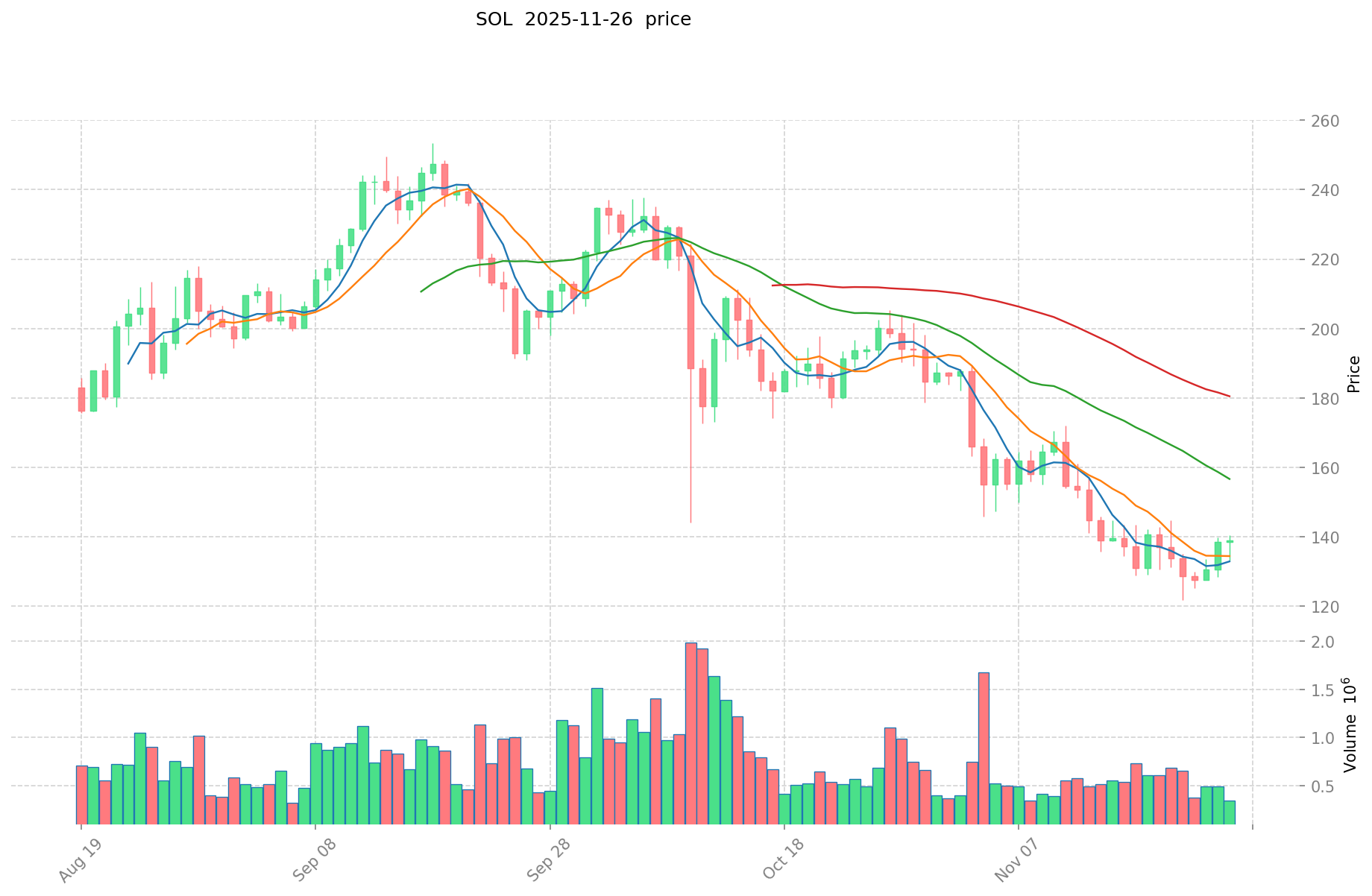SIN vs SOL: The Battle Between Singapore's Old and New Currencies
Introduction: SIN vs SOL Investment Comparison
In the cryptocurrency market, SIN vs SOL comparison has always been a topic that investors cannot avoid. The two not only have significant differences in market cap ranking, application scenarios, and price performance, but also represent different crypto asset positions.
Sinverse (SIN): Since its launch in 2021, it has gained market recognition for its position as a Metaverse multi-player game built on Blockchain Technology.
Solana (SOL): Since its inception in 2017, it has been hailed as a high-performance blockchain protocol designed to enable scalability, and is one of the cryptocurrencies with the highest global trading volume and market capitalization.
This article will comprehensively analyze the investment value comparison between SIN and SOL, focusing on historical price trends, supply mechanisms, institutional adoption, technological ecosystems, and future predictions, and attempt to answer the question that investors care most about:
"Which is the better buy right now?"
I. Price History Comparison and Current Market Status
SIN and SOL Historical Price Trends
- 2021: SIN reached its all-time high of $0.710213 on November 28, 2021.
- 2025: SOL reached its all-time high of $293.31 on January 19, 2025.
- Comparative analysis: SIN has experienced a significant decline from its all-time high, currently trading at $0.0005655, while SOL has shown more resilience, trading at $143.08.
Current Market Situation (2025-11-27)
- SIN current price: $0.0005655
- SOL current price: $143.08
- 24-hour trading volume: $17,522.47 (SIN) vs $71,607,546.82 (SOL)
- Market Sentiment Index (Fear & Greed Index): 20 (Extreme Fear)
Click to view real-time prices:
- Check SIN current price Market Price
- Check SOL current price Market Price


II. Core Factors Affecting the Investment Value of SIN vs SOL
Supply Mechanism Comparison (Tokenomics)
-
SIN: Limited supply with maximum cap of 1 billion tokens, with burning mechanism reducing circulating supply
-
SOL: Inflationary model with declining inflation rate, started at 8% and decreases by 15% annually until reaching 1.5% long-term inflation
-
📌 Historical Pattern: Fixed supply models like SIN typically create scarcity-driven value appreciation during periods of increased adoption, while SOL's decreasing inflation model aims to balance network security funding with token value preservation.
Institutional Adoption and Market Applications
- Institutional Holdings: SOL has gained more institutional traction with investments from major funds like Alameda Research, Multicoin Capital, and increased presence in institutional products
- Enterprise Adoption: SOL demonstrates stronger enterprise integration through partnerships with companies like Brave Browser, Circle, and FTX, while SIN has focused more on retail applications
- Regulatory Stance: SOL has navigated regulatory environments more effectively with clearer compliance frameworks, while SIN faces varied regulatory treatment across jurisdictions
Technical Development and Ecosystem Building
- SIN Technical Upgrades: Enhanced privacy features and cross-chain interoperability improvements to facilitate broader network connectivity
- SOL Technical Development: Continuous improvements to consensus algorithm and processing capacity, with focus on maintaining high TPS (transactions per second) and low transaction costs
- Ecosystem Comparison: SOL has developed a more robust ecosystem across DeFi, NFT marketplaces, and dApps with over $10B in TVL, while SIN's ecosystem remains more specialized with focus on privacy applications and cross-chain solutions
Macroeconomic Factors and Market Cycles
- Performance in Inflationary Environments: SIN's fixed supply model potentially offers stronger store of value properties during inflation, while SOL's utility-focused model performs based on network growth
- Macroeconomic Monetary Policy: Both tokens show sensitivity to Federal Reserve policies, with tightening cycles typically creating stronger headwinds for SOL's growth-oriented ecosystem
- Geopolitical Factors: SIN's privacy features may provide advantage during periods of cross-border capital controls, while SOL's ecosystem breadth offers resilience through diversification across global markets
III. 2025-2030 Price Prediction: SIN vs SOL
Short-term Prediction (2025)
- SIN: Conservative $0.00036032 - $0.000563 | Optimistic $0.000563 - $0.00076005
- SOL: Conservative $117.506 - $143.3 | Optimistic $143.3 - $157.63
Mid-term Prediction (2027)
- SIN may enter a growth phase, with expected prices $0.0006733662975 - $0.0008281631475
- SOL may enter a consolidation phase, with expected prices $102.376386 - $172.252332
- Key drivers: Institutional capital inflow, ETF, ecosystem development
Long-term Prediction (2030)
- SIN: Base scenario $0.001067931374646 - $0.001164045198364 | Optimistic scenario $0.001164045198364+
- SOL: Base scenario $209.3554843128 - $307.752561939816 | Optimistic scenario $307.752561939816+
Disclaimer: The above predictions are based on historical data and current market trends. Cryptocurrency markets are highly volatile and subject to rapid changes. These predictions should not be considered as financial advice. Always conduct your own research before making investment decisions.
SIN:
| 年份 | 预测最高价 | 预测平均价格 | 预测最低价 | 涨跌幅 |
|---|---|---|---|---|
| 2025 | 0.00076005 | 0.000563 | 0.00036032 | 0 |
| 2026 | 0.0008864435 | 0.000661525 | 0.00064167925 | 16 |
| 2027 | 0.0008281631475 | 0.00077398425 | 0.0006733662975 | 36 |
| 2028 | 0.001001342123437 | 0.00080107369875 | 0.000504676430212 | 41 |
| 2029 | 0.001234654838198 | 0.000901207911093 | 0.000477640192879 | 59 |
| 2030 | 0.001164045198364 | 0.001067931374646 | 0.000939779609688 | 88 |
SOL:
| 年份 | 预测最高价 | 预测平均价格 | 预测最低价 | 涨跌幅 |
|---|---|---|---|---|
| 2025 | 157.63 | 143.3 | 117.506 | 0 |
| 2026 | 174.5394 | 150.465 | 109.83945 | 5 |
| 2027 | 172.252332 | 162.5022 | 102.376386 | 13 |
| 2028 | 227.63308176 | 167.377266 | 122.18540418 | 16 |
| 2029 | 221.2057947456 | 197.50517388 | 140.2286734548 | 38 |
| 2030 | 307.752561939816 | 209.3554843128 | 165.390832607112 | 46 |
IV. Investment Strategy Comparison: SIN vs SOL
Long-term vs Short-term Investment Strategy
- SIN: Suitable for investors focused on privacy features and cross-chain potential
- SOL: Suitable for investors seeking ecosystem growth and institutional adoption
Risk Management and Asset Allocation
- Conservative investors: SIN: 10% vs SOL: 90%
- Aggressive investors: SIN: 30% vs SOL: 70%
- Hedging tools: Stablecoin allocation, options, cross-currency portfolios
V. Potential Risk Comparison
Market Risk
- SIN: Higher volatility due to lower market cap and trading volume
- SOL: Susceptible to broader crypto market trends and macroeconomic factors
Technical Risk
- SIN: Scalability, network stability
- SOL: Centralization concerns, potential security vulnerabilities
Regulatory Risk
- Global regulatory policies may have differing impacts on both tokens, with SIN potentially facing more scrutiny due to privacy features
VI. Conclusion: Which Is the Better Buy?
📌 Investment Value Summary:
- SIN advantages: Limited supply, privacy features, cross-chain interoperability
- SOL advantages: Strong ecosystem, institutional adoption, high performance blockchain
✅ Investment Advice:
- New investors: Consider a higher allocation to SOL due to its established ecosystem and market position
- Experienced investors: Balanced portfolio with both SIN and SOL, leveraging SIN's potential for higher growth and SOL's stability
- Institutional investors: Focus on SOL for its liquidity and regulatory compliance, with potential small allocation to SIN for diversification
⚠️ Risk Warning: Cryptocurrency markets are highly volatile. This article does not constitute investment advice. None
VII. FAQ
Q1: What are the key differences between SIN and SOL? A: SIN is a Metaverse multi-player game token with a limited supply cap of 1 billion, while SOL is a high-performance blockchain protocol with an inflationary model. SOL has a larger market cap, higher trading volume, and more institutional adoption, while SIN focuses more on privacy features and cross-chain interoperability.
Q2: Which token has performed better historically? A: SOL has shown more resilience in price performance. It reached its all-time high of $293.31 in January 2025 and is currently trading at $143.08. SIN reached its all-time high of $0.710213 in November 2021 but has experienced a significant decline, currently trading at $0.0005655.
Q3: How do the supply mechanisms of SIN and SOL differ? A: SIN has a limited supply with a maximum cap of 1 billion tokens and includes a burning mechanism. SOL has an inflationary model with a declining inflation rate, starting at 8% and decreasing by 15% annually until reaching 1.5% long-term inflation.
Q4: Which token has better institutional adoption? A: SOL has gained more institutional traction with investments from major funds like Alameda Research and Multicoin Capital. It also has stronger enterprise integration through partnerships with companies like Brave Browser, Circle, and FTX.
Q5: What are the predicted price ranges for SIN and SOL in 2030? A: For SIN, the base scenario predicts a range of $0.001067931374646 - $0.001164045198364, with an optimistic scenario above $0.001164045198364. For SOL, the base scenario predicts a range of $209.3554843128 - $307.752561939816, with an optimistic scenario above $307.752561939816.
Q6: How should investors allocate their portfolio between SIN and SOL? A: Conservative investors might consider allocating 10% to SIN and 90% to SOL, while aggressive investors might allocate 30% to SIN and 70% to SOL. New investors may want to consider a higher allocation to SOL due to its established ecosystem and market position.
Q7: What are the main risks associated with investing in SIN and SOL? A: SIN faces higher volatility due to its lower market cap and trading volume, as well as potential scalability and network stability issues. SOL is susceptible to broader crypto market trends and macroeconomic factors, and has centralization concerns and potential security vulnerabilities. Both tokens may be impacted by global regulatory policies, with SIN potentially facing more scrutiny due to its privacy features.
Share
Content